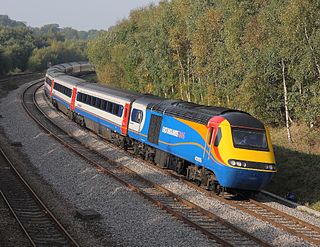
The Midland Main Line (MML) is a major railway line from London to Sheffield in Yorkshire via the East Midlands. It comprises the lines from London's St Pancras station via Leicester, Derby/Nottingham and Chesterfield.

St Pancras railway station, officially known since 2007 as London St Pancras International, is a central London railway terminus on Euston Road in the London Borough of Camden. It is the terminus for Eurostar services from Belgium, France and the Netherlands to London. It provides East Midlands Railway services to Leicester, Corby, Derby, Sheffield and Nottingham on the Midland Main Line, Southeastern high-speed trains to Kent via Ebbsfleet International and Ashford International, and Thameslink cross-London services to Bedford, Cambridge, Peterborough, Brighton, Horsham and Gatwick Airport. It stands between the British Library, the Regent's Canal and London King's Cross railway station, with which it shares a London Underground station, King's Cross St Pancras.

King's Cross Thameslink station is a closed railway station in central London, England. It is located on Pentonville Road, around 250 metres (0.2 mi) east of King's Cross mainline station. At the time of closure, in 2007, it was served by Thameslink trains and managed by First Capital Connect. Services have been transferred to a new station underneath St Pancras.

Derby railway station is a main line railway station serving the city of Derby in Derbyshire, England. Owned by Network Rail and managed by East Midlands Railway, the station is also used by CrossCountry services.

Hendon railway station is on the Midland Main Line in England, in West Hendon in the London Borough of Barnet, north London. It is 6 miles 79 chains (11.2 km) down the line from St Pancras and is situated between Brent Cross West to the south and Mill Hill Broadway to the north. Its three-letter station code is HEN.
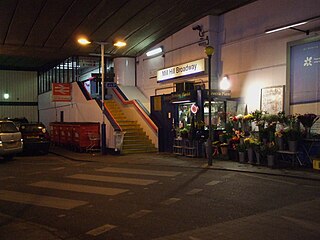
Mill Hill Broadway railway station is on the Midland Main Line in England, serving the suburb of Mill Hill in the London Borough of Barnet, north London. It is 9 miles 28 chains (15.0 km) down the line from St Pancras and is situated between Hendon to the south and Elstree & Borehamwood to the north. Its three-letter station code is MIL.
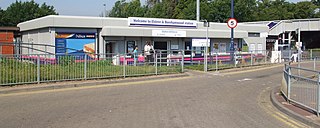
Elstree & Borehamwood railway station is a railway station in the town of Borehamwood, Hertfordshire, England. It primarily serves Borehamwood as well as the nearby village of Elstree, 1.3 miles (2.1 km) to the south-west. The station is situated on the Midland Main Line, 12 miles 35 chains (20.0 km) down the line from London St Pancras and is situated between Mill Hill Broadway to the south and Radlett to the north. Its three-letter station code is ELS.
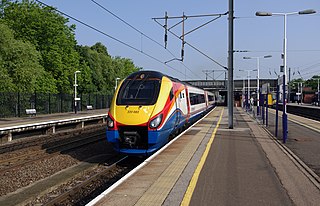
Bedford railway station is the larger of two railway stations in the town of Bedford in Bedfordshire, England. It is on the Midland Main Line from London St Pancras to the East Midlands and the terminus of the Marston Vale line from Bletchley through Bedford St Johns.

Leighton Buzzard railway station serves the towns of Leighton Buzzard and Linslade in the county of Bedfordshire and nearby areas of Buckinghamshire. Actually situated in Linslade, the station is 40 miles (64 km) north west of London Euston and is served by London Northwestern Railway services on the West Coast Main Line. Until the 1960s the station was the start of a branch to Dunstable and Luton, with a junction just north of the present station. The station has four platforms. Platforms 1 & 2 serve the fast lines and are used by Avanti West Coast services running non-stop to/from London Euston. Platforms 3 & 4 are served by slower London Northwestern railway services to/from London Euston.

Harlington railway station is located in Bedfordshire. It is named after the village of Harlington, on the outskirts of which it is located, but serves a wide rural area including the larger villages of Toddington and Barton-le-Clay.

Luton Airport Parkway railway station is on the Midland Main Line in England, serving south Luton and Luton Airport in Bedfordshire. The station is situated in Luton's Park Town district, being 29.27 miles (47.11 km) from London St Pancras between Harpenden to the south and Luton to the north. Its three-letter station code is LTN, also the IATA code for the airport.

St Albans City railway station, also known simply as St Albans, is one of two railway stations serving the city of St Albans in Hertfordshire, England. The 'City' station is the larger of the two, as it is on the better-connected Midland Main Line 19 miles 71 chains (32.0 km) from London St Pancras, being served by Govia Thameslink trains on the Thameslink route.

Kettering railway station serves the town of Kettering in Northamptonshire, England. It lies south-west of the town centre, on the Midland Main Line, 71 miles (115 km) north of London St. Pancras.

Long Eaton railway station serves the town of Long Eaton in Derbyshire, England. It lies on the Midland Main Line and the Derby-Nottingham line 120 miles 28 chains (193.7 km) north of London St Pancras. The station is managed by East Midlands Railway, but CrossCountry operates some services.

West Hampstead Thameslink is a National Rail station on the Midland Main Line and is served by Thameslink trains as part of the Thameslink route between Kentish Town and Cricklewood. The station is in Travelcard Zone 2.
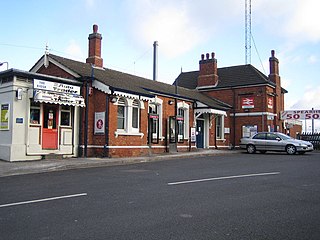
Leagrave railway station is located in Leagrave, a suburb in the north of Luton in Bedfordshire, England. Leagrave station is situated on the Midland Main Line 33¾ miles (54 km) north of London St Pancras International. The station is managed by Govia Thameslink Railway, and is served by the Thameslink route.

Radlett railway station is on the Midland Main Line in England, serving the village of Radlett, Hertfordshire. It is 15 miles 17 chains (24.5 km) down the line from London St Pancras and is situated between Elstree & Borehamwood to the south and St Albans City to the north. Its three-letter station code is RDT.

Harpenden railway station is on the Midland Main Line in England, serving the town of Harpenden, Hertfordshire. It is 24 miles 51 chains (39.7 km) down the line from London St Pancras and is situated between St Albans City to the south and Luton Airport Parkway to the north. Its three-letter station code is HPD.

Flitwick railway station is in the centre of Flitwick, in Bedfordshire, England. The station is situated on the Midland Main Line. The station is managed by Thameslink, who operate all trains serving it, and is served by Thameslink route services between Bedford and Brighton. As well as Flitwick itself, the station also serves the adjoining town of Ampthill, which no longer has its own station.
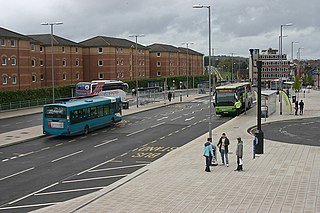
Luton is a town in the United Kingdom less than 30 miles (50 km) north of the centre of London, and has good transport links via the motorway network and the National Rail system. Luton is also home to Luton Airport, one of the major feeder airports for London and the southeast. The town is also served by buses run by Arriva Herts & Essex and other operators and has a guided busway. As a Unitary Authority, Luton Borough Council is responsible for local highways and public transport in the borough.





















